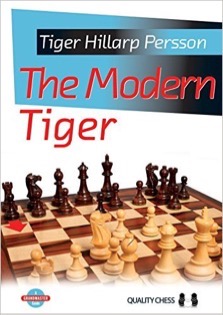Modern Tiger, The
Tiger Hillarp Persson

The Modern Tiger by Swedish Grandmaster Tiger Hillarp Persson is a greatly expanded followup to his book Tigers Modern published ten years ago. Like that work the focus is on the positions arising after 1.e4 g6 2.d4 Bg7. The bulk of the book is devoted to this “Modern move order and in particular variations where Black often follows up with an early …a6 aiming for …b5, …Bb7, …Nd7 and …c5 when allowed. Blacks king knight is slow to develop, so with but a few exceptions which will be discussed later, play does does not transpose to the Pirc. The approach advocated by Persson has picked up many followers the past decade including Vladimir Kramnik who appreciate its strategic complexity which allows Black to play for a win.
Almost 20 percent of The Modern Tiger is devoted to the Austrian Attack (1.e4 2.d4 3.Nc3 4.f4) which is arguably Whites most aggressive approach. The variations where Black meet this with an early …a6-b5 can be quite wild and not necessarily to everyones taste all the time. Recognizing this Persson devotes the next fifty pages of the book to the Pirc Austrian line 5 0-0, 6…Nc6, 7…e5 with deep annotations to the key game Bryson-Jones, Helensburgh 2013.
The author recommends a transposition to the Pirc when White fianchettoes his king bishop, opts for the Bc4 + Qe2 setup and plays the picky move order 1.e4 g6 2.d4 Bg7 3.Nf3 d6 4.Be2. Walter Browne played the latter way back in the early 1970s – White delays Nc3 until …Nf6. This discourages Hippo setups and those based on …a6 + …b5 as White can meet them with c4.
Persson recommends the Joel Benjamin favorite 1.e4 g6 2.d4 Bg7 3.Nf3 d6 4.Be2 Nf6 5.Nc3 0-0 6.0-0 e6!? against the Classical Variation. Here the author demonstrates his objectivity, which is present throughout the book. This is a book written from Blacks point of view so many authors would have gone out of there way to present an improvement for White? That would be 7.e5 dxe5 8.Nxe5! (not 7.dxe5 as seen in Yermolinsky-Benjamin, Denver 1998) when after 8…Nd5! (the authors T.N.) 9.Ne4 Nd7 10.f4 b6 11.c4 Ne7 12.Bf3 Bb7 13.Be3 Nf5 14.Bf2 Rb8 “White is slightly better, but Black is not without triumphs, and a complex battle lies ahead.
This is primarily a 1.e4 g6 book. The last 50-odd pages are devoted to the Averbakh line 1.e4 g6 2.d4 Bg7 3.c4 d6 4.Nc3 e5 which Persson believes might not be as good as the Kings Indian, but which is not only quite playable but avoids a huge amount of theory for those who do not have the KID in their repertoire. This is all true, and this book is already 536(!) pages, but note the move order is given as 1.e4. If White opens 1.d4 and Black answers 1…g6 the first player might opt for 2.c4 Bg7 3.Nc3 d6 4.Nf3 or fianchetto his king bishop – lines not covered in this already weighty tome.
Highly Recommended
